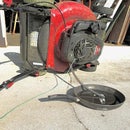Introduction: Custom Dolly for Metal Folding Chairs
Pictured is a standard commercial dolly for metal folding chairs (next to the wall) and a dolly I made from an old bed frame our neighbor set out on the curb on garbage day. The commercial unit is six feet long. Mine is four and one-half feet long so that it will fit on the elevator in our church building.
Most of our metal chairs are in the church basement.
Most of our metal chairs are in the church basement.
Step 1: Overflow
This is an entryway area behind the last row of pews in our church. One day we had a funeral for a very popular teacher. A couple of us had to lug chairs onto the elevator four at a time, and then carry them several yards so we could set them up. Our time was already short, and the last thing we needed was to spend extra time moving chairs manually. That was the day I decided we needed a dolly we could wheel onto the elevator, and then wheel to the set up point.
Step 2: On the Elevator
The church elevator is designed to be large enough for someone in a wheel chair and someone else to operate the elevator, as well as be with them in the elevator. The elevator is a little larger than it appears, but is still only slightly over four and one-half feet deep. The chair dolly holds 19 chairs when loaded carefully. There is room for one person to slip around the dolly and stand to the right of it in the elevator.
Step 3: Ready to Set Up
This is the same view in step 1, but with my chair dolly loaded and ready for setting up chairs in the main area where we can set extra chairs.
Step 4: Cut and Weld
I cut the bed frame rails to four and one-half feet for the two long pieces and cut three cross pieces just a little longer than the chairs are wide. The photo shows one of the front casters and the welds for the front cross piece.
Later I learned something important about welding. You can see from the heat marks that I welded across the rails. That creates a weak point. It would have been better if I had welded along the length of the rail rather than across the load bearing rails. Despite that, this dolly has held up well under use.
The casters at the front are uni-directional. The casters at the rear near the handle swivel.
Later I learned something important about welding. You can see from the heat marks that I welded across the rails. That creates a weak point. It would have been better if I had welded along the length of the rail rather than across the load bearing rails. Despite that, this dolly has held up well under use.
The casters at the front are uni-directional. The casters at the rear near the handle swivel.
Step 5: The Rear of the Dolly
I added an additional cross brace at the front of the casters. You can also see the verticals for the handle. The cross brace also serves to keep the first chairs loaded from sliding forward in the dolly frame. The second photo shows the rear end of the dolly from another perspective. I did not use any bracing for the verticals, but welded where I could to secure the verticals with more than one weld. Notice the swivel casters. Having them at the rear makes it easier to steer the dolly when loaded.
Step 6: A Long View of the Frame
This photo shows the whole frame of the dolly. About half-way to the front I added short sections of bed frame to keep the chairs from sliding too much when in the dolly. See the second photo for a close-up view. Again, I should have made the weld beads follow the length of the rails, not cross the rails.
Step 7: The Handle
It is not fancy, but I welded a piece of 1/2 inch black pipe across the two verticals in order to make a handle.
It might seem the dolly needs more bracing for the verticals, but when loaded with metal chairs; the chairs, themselves, provide a lot of resistance to any movement by the verticals and the chairs function as braces.
In addition to fitting onto our elevator, this dolly also makes it easier for someone to push around than pushing a longer, heavier dolly like the commercial units.
It might seem the dolly needs more bracing for the verticals, but when loaded with metal chairs; the chairs, themselves, provide a lot of resistance to any movement by the verticals and the chairs function as braces.
In addition to fitting onto our elevator, this dolly also makes it easier for someone to push around than pushing a longer, heavier dolly like the commercial units.











